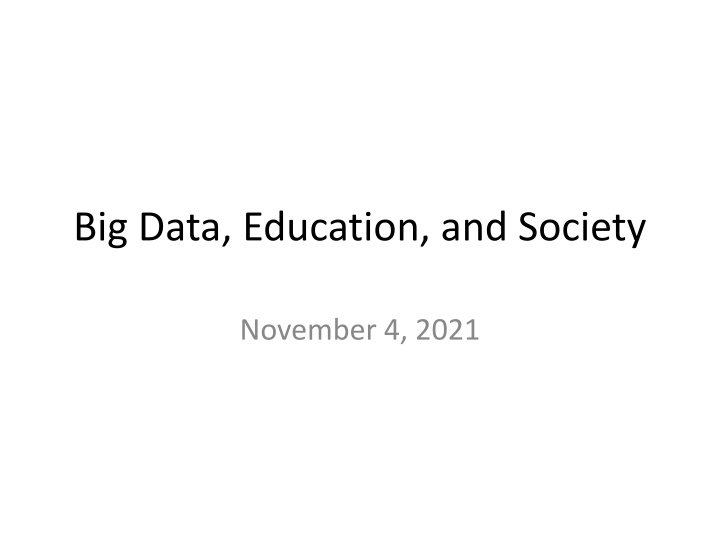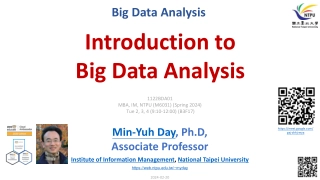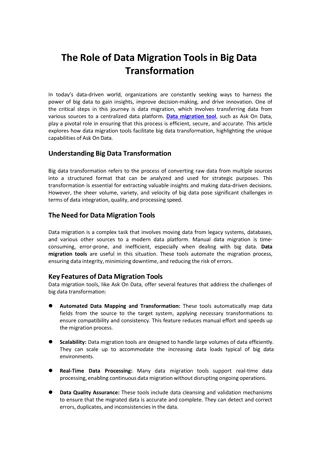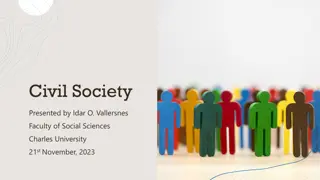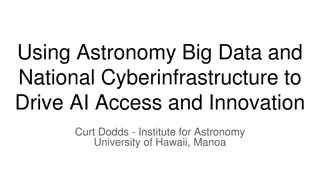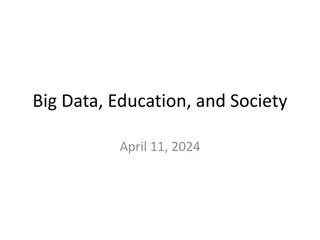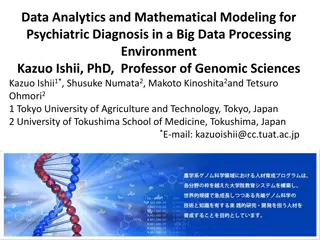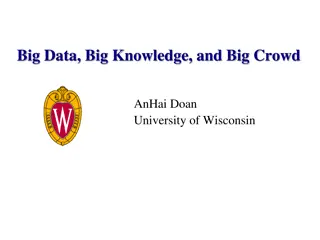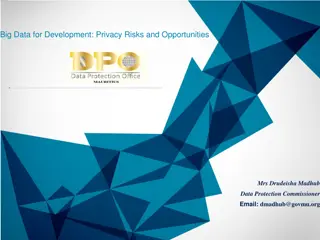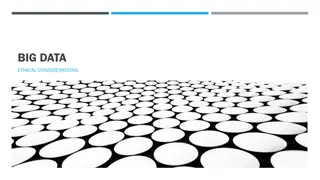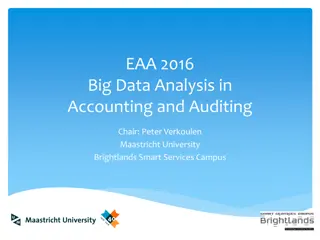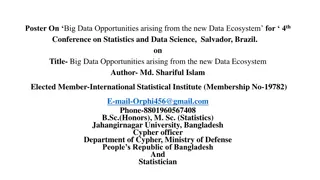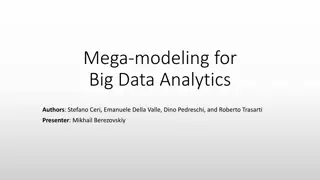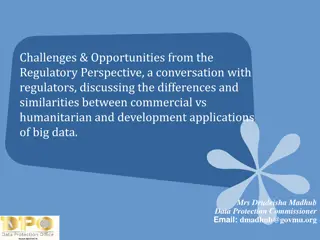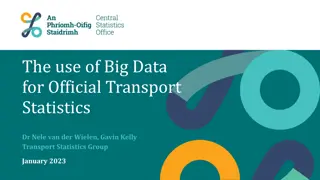Big Data, Education, and Society
This content delves into the intersections of big data, education, and society, offering insights and discussions on their evolving relationship and impact. Examining how data influences educational practices and societal structures, this piece prompts reflection on the dynamic landscape shaped by these interconnected forces. Insights shared on trends, challenges, and opportunities shed light on the evolving nature of utilizing data in educational and social contexts.
Download Presentation

Please find below an Image/Link to download the presentation.
The content on the website is provided AS IS for your information and personal use only. It may not be sold, licensed, or shared on other websites without obtaining consent from the author.If you encounter any issues during the download, it is possible that the publisher has removed the file from their server.
You are allowed to download the files provided on this website for personal or commercial use, subject to the condition that they are used lawfully. All files are the property of their respective owners.
The content on the website is provided AS IS for your information and personal use only. It may not be sold, licensed, or shared on other websites without obtaining consent from the author.
E N D
Presentation Transcript
Big Data, Education, and Society November 4, 2021
Assignment 3 Any questions about assignment 3?
Discrimination and the Perpetuation of Bias
Algorithmic Bias (Garcia, 2016) Nothing to do with the bias-variance trade- off , if you ve ever heard of that (And if you haven t don t worry about it)
Definition in Garcia (2016) When a prediction model implicitly discovers bias in existing decision-making and then perpetuates/systematicizes/extends it
Definition in Friedman & Nussbaum (1996) Biased computer systems systematically and unfairly discriminate against individuals or groups of individuals in favor of others.
Definition in Baker & Hawn (2021) Cases where model performance is substantially better or worse across mutually exclusive groups, separated by non-malleable factors
Does anyone want to propose a different definition? There are other definitions out there
Key difference between definitions If algorithms create a new bias or previously- unknown bias Is it still algorithmic bias? Baker & Hawn say yes Friedman & Nussbaum say yes Garcia says no
Is it a problem? If algorithms are biased in ways that match well-known societal biases Please post your thoughts in the chat
Is it a problem? If algorithms are biased in ways that match poorly-understood societal biases Please post your thoughts in the chat
Is it a problem? If algorithms are biased in ways that don t match societal biases Please post your thoughts in the chat
Another differentiation Algorithmic bias is found in automated decision-making Friedman & Nussbaum Garcia Algorithmic bias is found in measurement Baker & Hawn
Is it a problem? An algorithm makes biased measurements, but the actual decision-making is left to humans Please post your thoughts in the chat
Example (Garcia, 2016)
Example (Garcia, 2016)
Example (Corbett-Davies et al., 2017) For example, when ProPublica examined computer-generated risk scores in Broward County, Fla., in 2016, it found that black defendants were substantially more likely than whites to be rated a high risk of committing a violent crime if released. Even among defendants who ultimately were not re- arrested, blacks were more likely than whites to be deemed risky. These results elicited a visceral sense of injustice and prompted a chorus of warnings about the dangers of artificial intelligence.
Corbett-Davies et al. (2017) argument Yet those results don t prove the algorithm itself is biased against black defendants a point we ve made previously, including in peer- reviewed research. The Broward County classifications are based on recognized risk factors, like a documented history of violence. The classifications do not explicitly consider a defendant s race. Because of complex social and economic causes, black defendants in Broward County are in reality more likely than whites to be arrested in connection with a violent crime after release, and so classifications designed to predict such outcomes necessarily identify more black defendants as risky. This would be true regardless of whether the judgments were made by a computer or by a human decision maker. It is not biased algorithms but broader societal inequalities that drive the troubling racial differences we see in Broward County and throughout the country. It is misleading and counterproductive to blame the algorithm for uncovering real statistical patterns. Ignoring these patterns would not resolve the underlying disparities.
Where does algorithmic bias come from? Action/ Deployment Actual World Machine Learning Lifecycle Model Learning The Task Measurement/Data (Barocas et al., 2019; Cramer et al., 2019; Kizilcec & Lee, 2020)
Where does algorithmic bias come from? Action/ Deployment Actual World Machine Learning Lifecycle Model Learning The Task See review by Kizilcec & Lee (in press) Measurement/Data
Where does algorithmic bias come from? Action/ Deployment Actual World Machine Learning Lifecycle Model Learning The Task Measurement/Data See review by Baker & Hawn (2021)
Bias from Measurement/Data Collection Representational Bias (Suresh & Guttag, 2020) Model performs less well for group less represented in training data Suburban middle-class students Urban lower- income students Even a complete data set may not be enough if a group is rarely seen in the data set
Bias from Measurement/Data Collection Measurement Bias (Suresh & Guttag, 2020) Bias in Training Labels Judgement by others Judgement by self Human coders
Taking a first step: What do we know? (Baker & Hawn, 2021) Unknown Bias Known Bias Fairness Equity
What do we know about bias impacting learners in common demographic categories? [Industrial] Teams often struggled to anticipate which subpopulations and forms of unfairness they need to consider for specific kinds of ML applications. (Holstein et al., 2019) Most educational data mining research does not even mention learner demographics, much less research it (Paquette et al., 2020)
Race/Ethnicity A range of algorithms predicting course failure performed worse for African-American students, but results differed across university courses. (Hu & Rangwala, 2020) Algorithms predicting six-year college graduation had higher false positive rates for White students and higher false negative rates for Latino students. (Anderson et. al, 2019) An algorithm for predicting course grades performed worse for students in underrepresented racial and ethnic groups than for White and Asian students (Lee & Kizilcec, 2020) Algorithms predicting college dropout had lower true negative rates but better recall for students who are not White or Asian (Yu et al, 2021) When race data was included in the model, students of several racial backgrounds were inaccurately predicted to perform worse than other students in undergraduate success. (Yu et al., 2020)
Nationality On a test of foreign language proficiency, the E-Rater system inaccurately gave Chinese and Korean students higher scores than human essay raters. (Bridgeman et al., 2009, 2012) Arabic and Hindi-speaking students were given lower scores [than human raters] on the same test. (Bridgeman et al., 2012) Models built using data from learners in the Philippines, Costa Rica, and the United States were each more accurate on students from their own countries than for students from other countries. (Ogan et al., 2015) Models predicting standardized examination scores trained on data from the USA were more accurate for students in economically developed countries than students in less economically developed countries (Li et al., 2021)
Gender A range of algorithms predicting course failure performed worse for male students, but the result was inconsistent across university courses. (Hu & Rangwala, 2020) Algorithms predicting six-year college graduation had higher false negative rates for male students. (Anderson et. al, 2019) Algorithms predicting MOOC dropout performed worse for female students than male students. (Gardner et al., 2019) An algorithm for predicting course grades performed worse for males than for female students. (Lee & Kizilcec, 2020) Female students were inaccurately predicted to perform better for undergraduate success than male students. (Yu et al., 2020) Algorithms predicting college dropout had lower true negative rates but better recall for male students (Yu et al, 2021)
Gender While performance was good for both males and females, a JRip decision tree model predicting student retention performed well for males and females and more equitably than a J48 decision tree model. But, the JRip model still had moderately better performance for female students. (Kai et al., 2017). Only small differences in performance between males and females were found predicting course outcomes and school dropout. (Christie et al., 2019; Riazy et al., 2020)
What do we know about bias impacting other groups? Do we even know about all the groups that are impacted?
Native language and dialect Algorithmic essay scoring developed on corpuses more relevant to native speakers than second- language speakers (Naismith et al., 2018) No work on algorithmic bias in education in terms of learner dialect Although there has been work to develop learning systems that are appropriate for speakers of non- traditional dialects (e.g. Finkelstein et al., 2013)
Disabilities Accuracy of speech recognition system used in educational assessment much lower for students with speech impairment (Loukina et al., 2018) Evidence of disparate impact in course outcome prediction for students who self-reported that they had some disability (Riazy et al., 2020)
Urbanicity Detectors of student affect significantly less effective when transferred between urban, rural, and suburban students (Ocumpaugh et al., 2014) Models of attributes of student questions not impacted by transfer between urban, rural, and suburban students (Samei et al., 2015)
Parental Educational Background Model predicting college success more likely to inaccurately predict negative outcomes for first- generation college students if personal background included in model (Yu et al., 2020) Model predicting retention in online program more accurate for first-generation college students (Kai et al., 2017) Algorithms predicting college dropout had lower true negative rates but better recall for first- generation students (Yu et al, 2021)
Socioeconomic Status (SES) Model predicting college success more likely to inaccurately predict negative outcomes for students from poorer families if personal background included in model (Yu et al., 2020) Models predicting student success mildly less accurate if transferred between schools with different SES profiles (Yudelson et al., 2014) Algorithms predicting college dropout had lower true negative rates but better recall for lower-SES students (Yu et al, 2021)
International Students Model predicting college success more likely to inaccurately predict negative outcomes for international college students if personal background included in model (Yu et al., 2020)
Military-Connected Status Model predicting high school dropout less accurate if developed for non-military connected students and applied to military- connected students, or vice-versa (Baker et al., 2020)
Strong evidence that bias impacts a wide range of groups It s likely that other groups -- not yet studied -- are also impacted.
Other takeaways from Baker & Hawn (2021) Models trained on one group of learners generally perform more poorly for new groups. Investigation of bias for many groups still missing, e.g. Indigenous learners, specific disabilities, religious minorities, non-binary and transgender learners. Collecting and training on a diverse sample of students can help. The super-majority of the empirical research on algorithmic bias in education was conducted by North America universities/organizations (but see K ser, 2014; Klingler et al., 2017; Riazy et al., 2019 )
What could be solutions to preventing algorithmic bias? Your ideas?
What could be solutions to preventing algorithmic bias? Actually look for it (Paquette et al., 2020) Depends on collecting the necessary data (Baker & Hawn, 2021)
What could be solutions to preventing algorithmic bias? Make sure data sets are actually representative
What could be solutions to preventing algorithmic bias? Avoid using demographic variables as predictors (GPDR) Broaden the community of people developing models (Garcia, 2016) Predict outcomes that are not biased example given of predicting violent crime (less biased) instead of predicting all crime (more biased) (Corbett-Davies et al., 2017)
What could be solutions to preventing algorithmic bias? Right to explanation (GPDR) Inspect model outcomes for bias Do visibly biased outcomes result? (Garcia, 2016) Is the model more biased than its training data? Openness as to model internals and predictions (Garcia, 2016)
What could be solutions to preventing algorithmic bias? Create guidelines for demonstrating a technology is not biased During publication Prior to use by school district
What could be solutions to preventing algorithmic bias? Better tools for doing a standard set of analyses of algorithmic biases Tools for conducting analyses on full data including demographics while preventing download of PII
